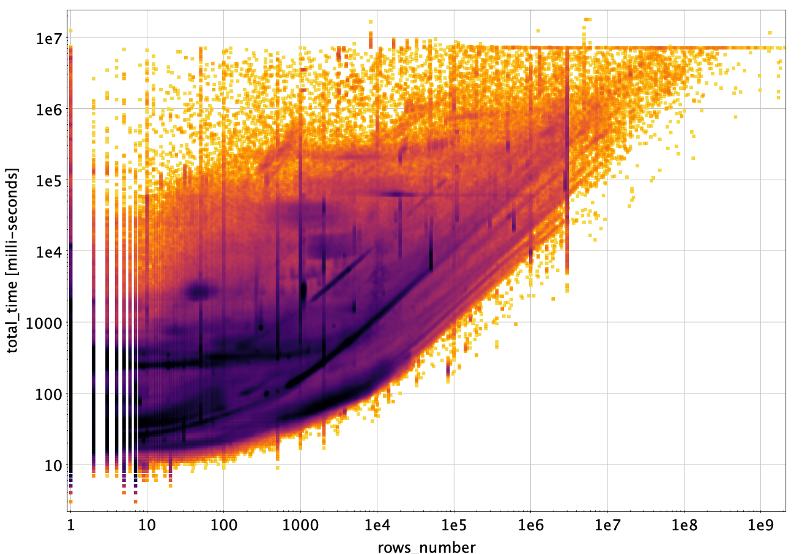IoW_20220328 - Gaia
Image of the Week
Gaia query statistics
Execution time of the ADQL queries that have been submitted to the ESA Gaia Archive between 19 October 2020 and 9 December 2021. On the x-axis the number of rows / objects resulting from the query, on a logarithmic scale. On the y-axis the execution time of each query in units of milli-seconds, also on a logarithmic scale.
With the Gaia mission being one of ESA’s power houses in terms of generating scientific results and publications, it is no surprise that the Gaia ESA Archive at the ESAC Science Data Centre is in popular demand. On average, the Archive receives more than 1 query per second (around the clock) defined in the Astronomical Data Query Language (ADQL).
With the aim to understand how astronomers use the Gaia Archive, such that we can improve it further following user demand, we have retrieved a set of 46,434,108 (anonymized and treated confidentially) ADQL queries that have been submitted to the Gaia ESA Archive between 19 October 2020 and 9 December 2021.
In addition to the actual text of the queries, this data set contains valuable information such as the query results size, the start and execution time, and the client used to connect to the Archive (e.g., Astroquery, TOPCAT, etc.). A detailed analysis of this multi-dimensional data has just started, with the support of two trainees, but it is already clear from the accompanying figure that the data set contains much food for thought.
The figure shows the execution time of each query (total_time, in units of milli-seconds, in logarithmic scale) versus the number of rows / objects resulting from the query (rows_number, also in logarithmic scale). Darker colours indicate more queries. The data show a wide variety of features (vertical stripes, horizontal stripes, parallel diagonal bands, blobs, etc.), demanding a deeper analysis. Needless to say: we are very excited to continue our dive into this goldmine of information!
Credits: ESA/Gaia/DPAC; Jos de Bruijne (Gaia Archive Scientist), Héctor Cánovas (Gaia Support Archive Scientist, Telespazio for ESA), Fredrik Hülpers (Young Graduate Trainee), Michal Durovič
[Published: 28/03/2022]
- Removed a total of (4) style text-align:center;
- Removed a total of (2) style text-align:justify;
Image of the Week Archive
- Removed a total of (1) border attribute.
- Removed a total of (1) cellpadding attribute.
- Removed a total of (1) cellspacing attribute.








































 Sign in
Sign in
 Science & Technology
Science & Technology
